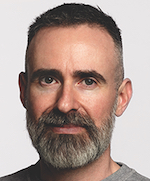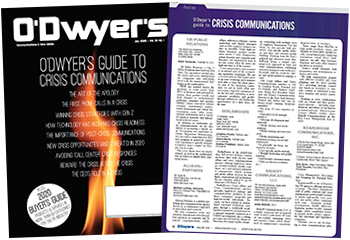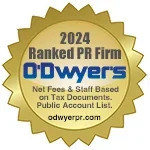 Nick Bailey Nick Bailey |
The communications world isn’t exactly light on stereotypes. The suited and slick account guy in the Don Draper mold (in the London ad world, where I spent most of my career, the account lead is still known colloquially as “the suit”), the rosé-swilling, sunburned network bigwig cruising the Croisette, the bearded, tattooed creative director (I count myself among their number).
But perhaps none of these clichés is more pernicious and more persistent than that of the larger-than-life PR professional; the laugh-a-minute, loud, life-and-soul of any party (hell, she probably arranged the party); the no-nonsense doer who makes magic happen by sheer force of personality.
 |
| This article is featured in O'Dwyer's Jan. '20 Crisis Communications Magazine. |
Like all clichés, there’s some justification for this one. As someone who spent most of his career in the tangentially-related world of digital creative, I’d rub up against “pure” PR agencies intermittently, usually around the point “our baby” was about to be born. The injection of this kind of hustle and energy was often critical to the success of initiatives born in the bubble of tech evangelism. There’s nothing quite like an efficient dose of reality from a great PR professional to prepare you for the more bruising dose of reality you’d otherwise receive when the rubber hits the unforgiving road of media and public opinion.
As the world changes around us, however—and as we seek to influence that change through creativity and communication—this narrow conception of what “good” PR looks and sounds like—and, indeed, what PR is even for—is becoming not just outdated, it’s limiting our ability to make genuine impact for our clients, and to claim our proper status in the communications mix.
When I began my creative career in the late ’90s, in the world of startup digital agencies, my qualifications were a fine art degree and a 23-year-old’s completely unjustified confidence in his own ability. Digital was so new that a bit of smart patter was enough to get me through the door: I’d never have got an entry-level job in today’s professionalized Hunger Game of agency careers, much less ascended through it as swiftly as I did (even with the way smoothed, as it no-doubt was, by my gender and ethnicity).
Nevertheless, being on the inside of an industry which, over the intervening 20 years, has exploded to dominance, has yielded one or two insights that might usefully apply to the world of earned media.
At the point my career began, the world of “traditional” public relations was arguably reaching its extrovert-fueled zenith, at least in the Anglo Saxon world. PR-driven advertising campaigns were making front-page news in the mainstream press (the Wonderbra campaign was a memorable watermark; whether it was a high or low one is a matter for debate). The industry was awash with money, and there was a general kowtowing to the views of “PR Gurus” as a new cult of “spin doctoring” was born around the reigns of Clinton and Blair.
Arguably, it was the scale of this success, and the complacency which stemmed from it, which has meant that the PR world has been slow to adapt to the disruptive impact of technology and digital media, and the positive change that can come from inviting those who think and behave differently into your organization.
An early challenge for the nascent digital creative industry was figuring out how to bring the necessarily unpredictable, instinctive and chaotic activity of creative endeavor together with the methodical, iterative process of technology development. People from diametrically diverse disciplines were forced to communicate who would in other circumstances most likely never have met; let alone collaborated.
This gave rise to lots of frustration and false starts (fortunately, clients had bigger budgets, less digital experience and more patience than they have today). But it also gave rise to extraordinary innovation, rapid change, industry disruption and leaps forward in the efficiency and effectiveness of advertising efforts.
There’s much chatter on this topic around “right-brained” creatives and “left-brained” tech people. Of course, this is reductive and arguably obscures more than it reveals; everybody boasts a spectrum of capabilities and predispositions, after all. But what this simplification does prove is that we instinctively recognize that these two disciplines require very different mental processes.
What they also require are different structures, resources and support from the employer. An environment that’s great for a creative isn’t necessarily great for a coder, and vice versa. Over the years, successful digital creative and technology companies have built their businesses around these requirements, and created fertile cultures that facilitate contributions from those that process information and express themselves in different ways.
This meant that when change came, these companies were ready to respond to and capitalize on it. When Facebook landed in 2004, it was digital agencies and startup specialists that leapt on the opportunity to build capability and expertise, not PR agencies.
In hindsight, this represents an extraordinary missed opportunity. After all, isn’t social media —and especially social media at its inception, when it was all about organic, not paid reach— the ultimate word-of-mouth, earned channel?
The fact that the PR industry largely sat on the sidelines of the digital revolution and has only recently leaned in to provide valuable expertise and insight is perhaps a reflection of that typically human pattern to double-down on the strategies that delivered success for you in the past in order to respond to novel challenges arising in the present.
If the extraordinary success of digitally-driven business over the last two decades proves one thing it’s this: you can’t predict or plan for the future, but you can build for it. By fostering cultures that welcome contributions from people who think, create, problem-solve and express themselves differently from the majority—which in the PR world means the charismatic extrovert—organizations become more responsive, adaptable and creative.
The most important lesson for me as a creative working with technology people was the insight it gave me into the limitations of my own approach. It challenged my assumptions about how things “should” be done and—most importantly—gave an understanding that there are different ways of seeing the world, which I had not considered before.
For an extrovert like me, that was the hardest skill I ever learned, and one which I still struggle with today: the ability to shut up and listen.
***
Nick Bailey is Creative Partner and CEO at futurefactor.


 The NBA, which promotes legalized gambling 24/7, seems more than hypocritical for banning player for placing bets... Diocese of Brooklyn promises to issue press release the next time one of its priests is charged with sexual abuse... Truth Social aspires to be one of Donald Trump's iconic American brands, just like Trump University or Trump Steaks or Trump Ice Cubes.
The NBA, which promotes legalized gambling 24/7, seems more than hypocritical for banning player for placing bets... Diocese of Brooklyn promises to issue press release the next time one of its priests is charged with sexual abuse... Truth Social aspires to be one of Donald Trump's iconic American brands, just like Trump University or Trump Steaks or Trump Ice Cubes. Publicis Groupe CEO Arthur Sadoun puts competition on notice... Macy's throws in the towel as it appoints two directors nominated by its unwanted suitor... The Profile in Wimpery Award goes to the Ford Presidential Foundation for stiffing American hero and former Wyoming Congresswoman Liz Cheney.
Publicis Groupe CEO Arthur Sadoun puts competition on notice... Macy's throws in the towel as it appoints two directors nominated by its unwanted suitor... The Profile in Wimpery Award goes to the Ford Presidential Foundation for stiffing American hero and former Wyoming Congresswoman Liz Cheney. JPMorgan Chase chief Jamie Dimon's "letter to shareholders" is a must-read for PR people and others interested in fixing America and living up to its potential... Get ready for the PPE shortage when the next pandemic hits... Nixing Netanyahu. Gaza carnage turns US opinion against Israel's prime minister.
JPMorgan Chase chief Jamie Dimon's "letter to shareholders" is a must-read for PR people and others interested in fixing America and living up to its potential... Get ready for the PPE shortage when the next pandemic hits... Nixing Netanyahu. Gaza carnage turns US opinion against Israel's prime minister. Trump Media & Technology Group sees Elon Musk's X as an option for those who want the free expression promised by Truth Social but without Donald Trump, owner of 57.3 percent of TMTG... Chalk one up for "anti-woke warrior" governor Greg Abbott as University of Texas lays off 60 DEI-related staffers... Five percent of Americans see the US as its own worst enemy, according to Gallup.
Trump Media & Technology Group sees Elon Musk's X as an option for those who want the free expression promised by Truth Social but without Donald Trump, owner of 57.3 percent of TMTG... Chalk one up for "anti-woke warrior" governor Greg Abbott as University of Texas lays off 60 DEI-related staffers... Five percent of Americans see the US as its own worst enemy, according to Gallup. Nine of the Top 100 firms that participated in O'Dwyer's rankings last year apparently threw in the towel for the 2024 scorecard. Seven other firms also went AWOL.
Nine of the Top 100 firms that participated in O'Dwyer's rankings last year apparently threw in the towel for the 2024 scorecard. Seven other firms also went AWOL.


 Have a comment? Send it to
Have a comment? Send it to 
No comments have been submitted for this story yet.